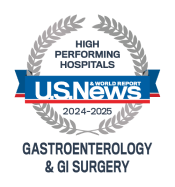Cryotherapy
Cryotherapy uses the extreme cold of liquid nitrogen to destroy abnormal, precancerous cells in the lining of the esophagus. One of the first centers in the world to use this cryotherapy, the University of Maryland Medical Center remains a pioneer in this treatment.
UMMC’s research study into cryotherapy's long-term effectiveness confirmed that precancerous or cancerous cells typically do not return (or can be effectively treated) within a five-year period. Read more about this pivotal new cryotherapy study.
What Does Cryotherapy Treat
- Barrett's esophagus when there is a high number of precancerous cells
- Some other types of pre-cancerous tissue in the esophagus
- Early stage esophageal cancer that is not amenable to standard therapies
Benefits of Cryotherapy
Successful cryotherapy avoids the need for alternative treatments, like surgery. This technique, which has minimal side effects, may be a good option for some people with early esophageal cancer who aren't eligible for surgery or have not responded to chemotherapy and radiation.
How Cryotherapy Works
Cryotherapy is not a single treatment but a series of them, performed every four to eight weeks until there’s no abnormal tissue detected. On average, patients require three to four treatments, depending on the extent of the abnormal tissues and their response. Some people might need eight or more.
Performed during an upper endoscopy (EGD), the doctor uses a lighted tube with a camera (the endoscope) to reach the affected area and spray liquid nitrogen on the esophagus. This freezes the tissues, destroying abnormal cells and allowing regrowth of new, healthy cells in their place.
Alternatives to Cryotherapy
To make an informed decision about cryotherapy, patients should know the other treatments for Barrett’s esophagus. They include:
- Observation - Patients have upper endoscopy usually every three to six months. If cancer develops, it is treated.
- Surgery - Surgical removal of the esophagus has a high success rate but involves a long recovery time, alteration in eating habits and the risk of complications.
- Photodynamic therapy (PDT) - A light-sensitizing drug and laser destroy the abnormal tissue. While there is more data on its success, PDT’s drawbacks are pain, the risk of esophageal scarring and the need to avoid direct sunlight for four to six weeks after treatment.
Cryotherapy Treatment Information for Patients
Before the Procedure
One week before, you will take a high dose of a common acid reflux medicine to decrease stomach acid that could flow back into your esophagus. You will continue to take this medicine throughout cryotherapy treatment.
The Procedure
An intravenous (IV) tube will deliver the medicine to sedate you. First, the doctor will use the endoscope to evaluate the esophagus lining. Next, a tube will be placed through your nose or mouth into your stomach to prevent air from building up in your stomach. The doctor then reinserts the endoscope and sprays liquid nitrogen on the esophagus.
After the Procedure
You will remain in the recovery area until you wake up. You cannot drive for eight hours. After each treatment, the nurse will call you by telephone and ask if you had side effects or any changes in your health.
Follow-Up Visits
After the full course of cryotherapy treatment, you will return for an upper endoscopy every three to six months for three years, after that once a year. Small samples of tissue will be taken and examined. If abnormal tissue is present, repeat cryotherapy treatments may be recommended.
Risks, Discomforts and Inconveniences
Much of the risks and discomfort in cryotherapy are the same as with upper endoscopy. They include:
- Mild discomfort due to gagging while the tube is passed down your throat
- Allergic reaction or irritation to your mouth or throat due to medication to numb it
- Allergic reaction to the sedation medicine or other problems like excessive sleepiness, slowed breathing or low blood pressure during the procedure
- Rarely, mild sore throat, chest pain or discomfort, painful or difficult swallowing, nausea, vomiting, fever or irregular heartbeat
- Even more rarely, aspiration, bleeding, or perforation
With cryotherapy, a rare complication is the narrowing of the esophagus so that it affects the ability to swallow food. If this happens, an upper endoscopy procedure can stretch the esophagus, which carries the risk of a tear.

